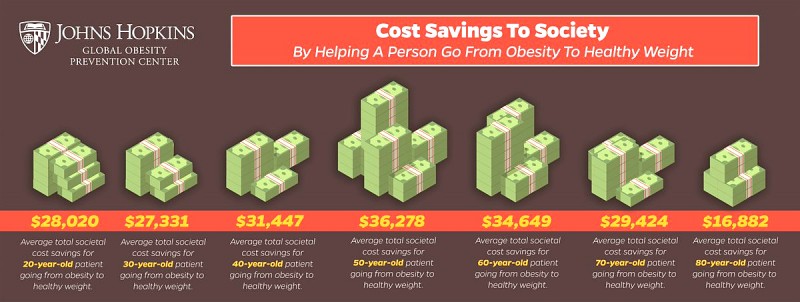Helping an adult lose weight leads to significant cost savings at any age, with those savings peaking at age 50, a new Johns Hopkins Bloomberg School of Public Health study suggests.
The findings, which were published online today in the journal Obesity, indicate that a 20-year-old adult who goes from being obese to overweight would save an average of $17,655 in direct medical costs and productivity losses over his or her lifetime. If the same person were to go from being obese to a healthy weight, the average savings would be $28,020. The expected average savings are even higher—$18,262 and $31,447, respectively—for a 40-year-old.
A high body mass index, or BMI, is linked to a higher risk of serious conditions like diabetes, cardiovascular disease, and some cancers. Subsequently, a high BMI and associated conditions can lead to high medical and societal costs and productivity losses. More than 70 percent of adults in the United States are considered to be overweight or obese, which in direct medical expenses alone costs nearly $210 billion per year.
"Over half the costs of being overweight can be from productivity losses, mainly due to missed work days. This means that just focusing on medical costs misses a big part of the picture, though they're a consideration, too," says Bruce Y. Lee, executive director of the Global Obesity Prevention Center at the Bloomberg School. "Productivity losses affect businesses, which in turn affects the economy, which then affects everyone."

When absenteeism occurs in the workforce, others, at times, have to take on a larger workload. This all funnels downstream and adds to the societal costs of obesity. And health insurance premiums increase across the board, even for healthy patients, as insurers spread the cost of obesity and its associated conditions.
For the study, the researchers developed a computational simulation model to represent the U.S. adult population to show the lifetime costs and health effects for an individual with obesity, overweight, and healthy weight statuses at ages 20 through 80 in increments of 10. The model simulated the weight and health status of an adult as he or she ages year by year throughout his or her lifetime to track the individual medical costs and productivity losses of each person. The estimated direct medical costs to the insurer and health care facility, productivity losses and sick time were included.
The research team found that cost savings peak at age 50 with an average total savings of $36,278. After age 50, the largest cost savings occur when an individual with obesity moves to the normal weight category as opposed to the overweight category, emphasizing the importance of weight loss as people age.
This finding is important because people aged 50 and older make up more than 60 percent of incremental societal costs, which includes higher taxes to support government insurance and higher copays and other out-of-pocket expenses.
"Most previous models have taken into account one or a few health risks associated with obesity. Subsequently, the forecasted costs may be unrealistic," says Saeideh Fallah-Fini, a former GOPC visiting scholar who was part of the research team. "In our study, the model we developed takes into account a range of immediate health complications associated with body weight, like hypertension or diabetes, as well as all major long-term adverse health outcomes, including heart disease and some types of cancer, in forecasting the incremental health effects and costs to give a realistic calculation."









